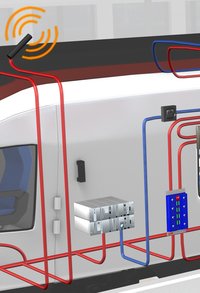 Communication inside railcars
Communication inside railcars
In a single traction system a railcar comprises firmly connected coach elements with two control heads. The railcar is only disconnected for maintenance purposes. Both driver's cabs, each of which is equipped with a control panel, communicate with the central VisiWeb computers. Activation of the driver's cab is signalled to the VisiWeb on-board computer, and the corresponding PIS control panel is activated. Communication takes place over the Ethernet infrastructure inside the vehicle. UIC cabling is available as a fallback.
Communication in multi-traction compositions
In multi-traction compositions several railcars are combined to form a single unit. The PIS control panel in the leading vehicle is activated automatically when the driver's cab in the leading vehicle is put into operation. The train driver enters the train/service/circulation number on the active control panel. The on-board computer in the leading vehicle forwards the necessary data on the train bus system, which is routed to the downstream on-board computers via the track disconnectable couplings. Accordingly, all on-board computers are able to take over control of the PIS from the leading railcar in the corresponding railcar. The multi-traction PIS works on the basis of the master-master principle. This means that functions such as "feeder train" or "lengthening/shortening" can be implemented with ease.
PIS train bus system with large bandwidth
The current state of the art makes it possible to route broadband communication systems such as Ethernet via track disconnectable automatic couplings. This means that, for the first time, applications in multi-traction compositions with large bandwidth requirements (such as forwarding of a video image from each railcar to the leading vehicle) can be used throughout the entire train composition. Ruf consultants will be pleased to advise vehicle constructors on the implementation of such communication systems.
Integration into existing network topologies
Manufacturers can integrate VisiWeb components into their existing vehicle networks with ease. As VisiWeb components support all common Ethernet standards and protocols, they provide an assurance not only of integration into the network structure but also of connectivity with third-party systems. The components are configured via web interfaces or using prepared configuration files which are distributed to them during installation and start-up.
Digital Ruf vehicle bus system with large bandwidth
In the absence of a vehicle manufacturer's network in the vehicle, communication takes place over the Ruf vehicle bus system. For communication in railcars VisiWeb uses Ethernet on copper cables or, as an option, fibre optic cables. The VisiWeb components already contain the necessary active components (switch) to create a redundant Ethernet ring. Redundancy is controlled by means of STP, RSTP and MRP algorithms. Apart from the ring structure, all other possible topologies - even mixed ones - are of course also supported. The large bandwidth permits central data storage in the VisiWeb computer. In comparison to conventional systems this has the advantage that data storage in remote displays or voice memories is not necessary.
Support of additional standards
If the vehicle is already equipped with an installation and if this complies with standards, the VisiWeb on-board computer has suitable interfaces:
- IBIS coach bus; conforming to VDV300
- MVB/WTB; conforming to IEC61375 and UIC556
- Support of the vehicle manufacturer's existing network topologies
- CAN bus; e.g. with CANopen protocol
- RS232 interfaces for individual devices
- RS485 interfaces for multi-unit applications
- Binary I/O control lines
- Lines with analog signals conforming to UIC568 or proprietary solutions (LBT, etc.)

